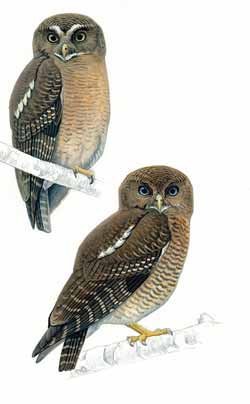Two new owls discovered in the Philippines

Two new species of owls have been discovered in the Philippines, and an MSU researcher played a key role in confirming their existence. (Top left: Cebu Hawk owl. Bottom right: Camiguin Hawk owl.) Courtesy of Oriental Bird Club: original painting by John Gale.<br>
The discovery, which is featured in the current issue of Forktail, the Journal of Asian Ornithology, took years to confirm, but it was well worth the effort, said the paper’s lead author Pam Rasmussen, MSU assistant professor of zoology and assistant curator of mammalogy and ornithology at the MSU Museum.
“More than 15 years ago, we realized that new subspecies of Ninox hawk-owls existed in the Philippines,” she said. “But it wasn’t until last year that we obtained enough recordings that we could confirm that they were not just subspecies, but two new species of owls.”
Announcing the finding of a single bird is rare enough. But the discovery of two new bird species in a single paper is so rare that Rasmussen and the other researchers couldn’t recall the last time it happened.
The first owl, the Camiguin Hawk-owl, is found only on the small island of Camiguin Sur, close to northern Mindanao. Despite being so close geographically to related owls on Mindanao, it has quite different physical characteristics and voice. At night, it gives a long solo song that builds in intensity, with a distinctive low growling tone. Pairs of owls give short barking duets that start with a growl. They also are the only owls to have blue-gray eyes.
The second new discovery was the Cebu Hawk-owl. This bird was thought to be extinct, as the forests of Cebu have almost all been lost due to deforestation. But it had never been considered a distinct form. Study of its structure and vocalizations confirmed that it was a new species. In fact, it was the unique calling or vocalizations of both owls that confirmed that the new classifications were warranted.
“The owls don’t learn their songs, which are genetically programmed in their DNA and are used to attract mates or defend their territory; so if they’re very different, they must be new species,” Rasmussen said. “When we first heard the songs of both owls, we were amazed because they were so distinctly different that we realized they were new species.”
The owls have avoided recognition as distinct species for so long because the group shows complex variation in appearance that had been poorly studied, and their songs were unknown. Both islands are off the beaten path for ornithologists and birders, who usually visit the larger islands that host more bird species.
Sound recordings of both new owl species and those from other islands are available free on AVoCet.
Since the discovery process is both tedious and time consuming, it took a team of scientists and contributors to confirm the owls’ existence. The team included individuals from BirdLife International, the Oriental Bird Club, Philippines Biodiversity Conservation Foundation Inc. and Birdtour Asia. Additional support was provided by National Geographic.
Michigan State University has been working to advance the common good in uncommon ways for more than 150 years. One of the top research universities in the world, MSU focuses its vast resources on creating solutions to some of the world’s most pressing challenges, while providing life-changing opportunities to a diverse and inclusive academic community through more than 200 programs of study in 17 degree-granting colleges.
Media Contact
More Information:
http://www.msu.eduAll latest news from the category: Life Sciences and Chemistry
Articles and reports from the Life Sciences and chemistry area deal with applied and basic research into modern biology, chemistry and human medicine.
Valuable information can be found on a range of life sciences fields including bacteriology, biochemistry, bionics, bioinformatics, biophysics, biotechnology, genetics, geobotany, human biology, marine biology, microbiology, molecular biology, cellular biology, zoology, bioinorganic chemistry, microchemistry and environmental chemistry.
Newest articles

Innovative 3D printed scaffolds offer new hope for bone healing
Researchers at the Institute for Bioengineering of Catalonia have developed novel 3D printed PLA-CaP scaffolds that promote blood vessel formation, ensuring better healing and regeneration of bone tissue. Bone is…

The surprising role of gut infection in Alzheimer’s disease
ASU- and Banner Alzheimer’s Institute-led study implicates link between a common virus and the disease, which travels from the gut to the brain and may be a target for antiviral…

Molecular gardening: New enzymes discovered for protein modification pruning
How deubiquitinases USP53 and USP54 cleave long polyubiquitin chains and how the former is linked to liver disease in children. Deubiquitinases (DUBs) are enzymes used by cells to trim protein…



